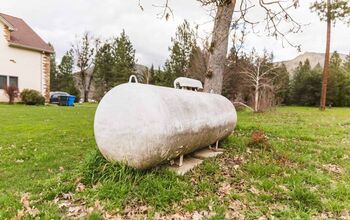Is An Expansion Tank Required For A Water Heater?

I remember the first time I saw an expansion tank on a water heater. I was in my friend’s basement and asked, “Hey, what’s that weird blocky tank thing on top of the boiler?” He explained that he recently had his water system replaced as a part of his home’s overhaul. What I was looking at was an expansion tank. But is it really necessary for people who want to keep up their home?
Expansion tanks are required for closed-system water heaters, not open-plumbing ones. If your system is closed, the hot water needs a place to transfer to when it expands. An expansion tank allows for water to freely transfer. You can hire a plumber for a PSI test to see if your system is open or closed.
If you are trying to redo your home or upgrade a heater, then you have to make decisions regarding an expansion tank. This guide will help you make the most of your decision-making time.
What Does An Expansion Tank Look Like?
Many people don’t know what an expansion tank looks like, but they should. In many cases, being able to spot an expansion tank can clue you in when it comes to figuring out your tank requirements. After all, if you have an expansion tank, chances are you will need to keep that status quo for safety reasons.
An expansion tank looks like a propane tank, and it’s located above the water heater. Like water heaters, expansion tanks are expected to be strapped in as a way to protect the tanks from spilling over in the event of an earthquake. If you see a second tank (usually white, beige, or blue) over your water tank, that’s the expansion tank.
Do You Always Need An Expansion Tank For Your Water Heater?
The clear answer here depends on your building codes, your water tank system, as well as your personal choices. The biggest issue is knowing whether you have an open or closed water system.
If you have an open water system, then any excess water will flow back into the water supply instead of staying stuck in your home. This reduces the risk of having a water tank burst due to built-up pressure, which means you can skip on the expansion tank if you so choose. However, some homeowners still add them just to be on the safe side.
A closed tank system means that water is trapped once it has been sent from the main water supply to your home. When this happens and water expands, it has nowhere to go. If pressure builds up due to high water temperatures, the only place it can go is an expansion tank. Otherwise, you’ll have an explosion.
How Can You Tell If You Need To Get An Expansion Tank For Your Water Heater?
There’s no guaranteed way to tell if you need an expansion tank by just looking at your water tank, though many plumbers will tell you that it’s okay to avoid a water expansion tank if you don’t currently have one. The best way to find out if you need a water heater is to have a plumber conduct a PSI test.
If you have a high PSI pressure rating inside your water heater, the best thing you can do for yourself and your home is to install an expansion tank—if you don’t have one already.
If You Have An Open Water System, Can You Still Get An Expansion Tank?
Expansion tanks are meant to prevent pressure bursts, and that makes them always a good choice to have. This may be true, even if you don’t need one. However, it’s worth pointing out that some systems may end up having low water pressure as a result of using an unnecessary expansion tank.
Adding an unnecessary expansion tank isn’t always the smartest thing to do. The best thing you can do, if you’re debating adding an expansion tank to an open system, is to call a plumber to ask for advice. Your plumber will be able to pair you with the right tank or tell you if a tank would be detrimental to your water quality.
What Do Building Codes Say About Water Expansion Tanks?
Every city’s building codes are going to be somewhat different, but when it comes to expansion tanks, there are some things that stay the same. Almost every single building code will require you to have a water expansion tank if you have a closed water system or a PSI reading above a certain level. That much is true. However, there are still nuances here:
- Some districts will require a water tank expansion regardless of the water system being used. This is often done just to be on the safe side, and it’s still relatively rare.
- Every district has its own maximum PSI reading for heaters without expansion tanks. You need to refer to your local building codes in order to find out what that PSI reading is in your neighborhood. From there, your plumber will be able to help you determine whether or not your building needs a tank.
- Most HOAs do not have any codes relating to water expansion tanks because they are not deemed a major issue when it comes to property values. It’s worth noting that most HOAs are primarily focused on outside appearances rather than interior issues. Unless you know that your homeowner’s association is uniquely picky, there’s probably no need to actually get them involved.
- If you live in Texas, you need an expansion tank as well as a pressure regulation valve. Texas has a statewide law about these matters, and it’s part of the overall building code for any home in the area.
Related Questions
Do I need more than one water expansion tank for the multiple heaters that I have?
This isn’t always necessary. The most important thing to remember is that you need an expansion tank for the overall size of the water flow in your home. It’s about proportions rather than the actual number of tanks. Talking to a plumber will help you figure out how large your expansion tank should be.
How long should a water expansion tank last?
This can vary greatly depending on how much water you use, the stress your water system is under, and more. Most homeowners would agree that their tanks last between two to six years with proper maintenance. It’s best to try to replace them a year after the factory warranty expires.
Can an expansion tank leak?
Like any other part of your plumbing, expansion tanks have the potential to leak. In fact, many do when they finally fail. The best way to prevent (or delay) a leak from occurring is to have your expansion tank carefully installed by a qualified plumber.
Do I need a Pressure Reducing Valve?
If your water pressure is above 80 PSI, an expansion tank alone will not be enough to keep your pressure low. You will need a pressure reducing valve, or PRV, to mitigate the high pressure of water coursing through your plumbing. Many plumbers will install PRVs and expansion tanks in the same sitting, just to make sure things are safe.

Ossiana Tepfenhart is an expert writer, focusing on interior design and general home tips. Writing is her life, and it's what she does best. Her interests include art and real estate investments.
More by Ossiana Tepfenhart



























